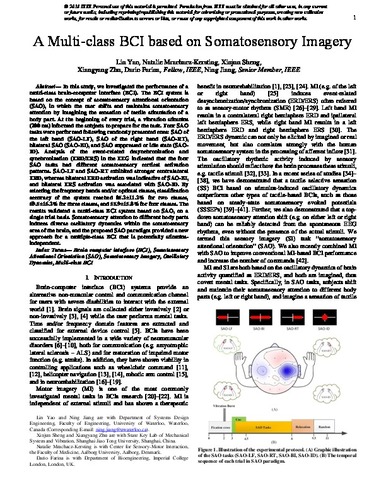| dc.contributor.author | Yao, Lin | |
| dc.contributor.author | Mrachacz-Kersting, Natalie | |
| dc.contributor.author | Sheng, Xinjun | |
| dc.contributor.author | Zhu, Xiangyang | |
| dc.contributor.author | Farina, Dario | |
| dc.contributor.author | Jiang, Ning | |
| dc.date.accessioned | 2018-06-20 14:40:24 (GMT) | |
| dc.date.available | 2018-06-20 14:40:24 (GMT) | |
| dc.date.issued | 2018-06-18 | |
| dc.identifier.uri | https://doi.org/10.1109/TNSRE.2018.2848883 | |
| dc.identifier.uri | http://hdl.handle.net/10012/13429 | |
| dc.description | © 2018 IEEE.Personal use of this material is permitted. Permission from IEEE must be obtained for all other uses, in any current or future media, including reprinting/republishing this material for advertising or promotional purposes,creating new collective works, for resale or redistribution to servers or lists, or reuse of any copyrighted component of this work in other works. | en |
| dc.description.abstract | In this study, we investigated the performance of a multi-class brain-computer interface (BCI). The BCI system is based on the concept of somatosensory attentional orientation (SAO), in which the user shifts and maintains somatosensory attention by imagining the sensation of tactile stimulation of a body part. At the beginning of every trial, a vibration stimulus (200 ms) informed the subjects to prepare for the task. Four SAO tasks were performed following randomly presented cues: SAO of the left hand (SAO-LF), SAO of the right hand (SAO-RT), bilateral SAO (SAO-BI), and SAO suppressed or idle state (SAO-ID). Analysis of the event-related desynchronization and synchronization (ERD/ERS) in the EEG indicated that the four SAO tasks had different somatosensory cortical activation patterns. SAO-LF and SAO-RT exhibited stronger contralateral ERD, whereas bilateral ERD activation was indicative of SAO-BI, and bilateral ERS activation was associated with SAO-ID. By selecting the frequency bands and/or optimal classes, classification accuracy of the system reached 85.2±11.2% for two classes, 69.5±16.2% for three classes, and 55.9±15.8% for four classes. The results validated a multi-class BCI system based on SAO, on a single trial basis. Somatosensory attention to different body parts induces diverse oscillatory dynamics within the somatosensory area of the brain, and the proposed SAO paradigm provided a new approach for a multiple-class BCI that is potentially stimulus-independent. | en |
| dc.description.sponsorship | University Starter Grant, University of Waterloo (No. 203859) | en |
| dc.description.sponsorship | National Natural Science Foundation of China (Grant No. 51620105002) | en |
| dc.language.iso | en | en |
| dc.publisher | Institute of Electrical and Electronics Engineers | en |
| dc.subject | Bars | en |
| dc.subject | Brain computer interface (BCI) | en |
| dc.subject | Brain-computer interfaces | en |
| dc.subject | Electroencephalography | en |
| dc.subject | Multi-class BCI | en |
| dc.subject | Oscillatory Dynamics | en |
| dc.subject | Robot sensing systems | en |
| dc.subject | Somatosensory Attentional Orientation (SAO) | en |
| dc.subject | Somatosensory Imagery | en |
| dc.subject | Standards | en |
| dc.subject | Task analysis | en |
| dc.subject | Vibrations | en |
| dc.title | A Multi-class BCI based on Somatosensory Imagery | en |
| dc.type | Article | en |
| dcterms.bibliographicCitation | Yao, L., Mrachacz-Kersting, N., Sheng, X., Zhu, X., Farina, D., & Jiang, N. (2018). A Multi-class BCI based on Somatosensory Imagery. IEEE Transactions on Neural Systems and Rehabilitation Engineering, 1–1. https://doi.org/10.1109/TNSRE.2018.2848883 | en |
| uws.contributor.affiliation1 | Faculty of Engineering | en |
| uws.contributor.affiliation2 | Systems Design Engineering | en |
| uws.typeOfResource | Text | en |
| uws.typeOfResource | Text | en |
| uws.peerReviewStatus | Reviewed | en |
| uws.scholarLevel | Faculty | en |

